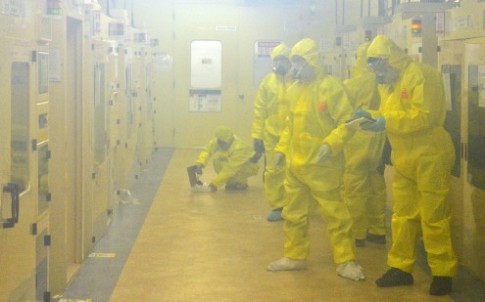<On Feb. 27, 2013, the South Korean police released CCTV footage of hydrofluoric acid gas leaks at Samsung. The leaks, caused on Jan. 27-28 by gaskets that were in use beyond replacement time, killed one worker and injured four. >
The chronic safety negligence that led to chemical leaks, and ensuing cover-ups of the incidents that resulted in one death and four injuries, were not sufficiently serious for the South Korean government to pursue criminal charges against top executives at Samsung Electronics Co., Ltd.
On Feb. 27, the South Korean police said it would criminally charge seven individuals for negligence in the hydrofluoric acid leaks of Jan. 28-29 at a Samsung chip plant in Hwaseong, about 70 kilometers south of Seoul.
Among the seven individuals, a 34 years old contract worker identified by his last name of Park, died of exposure to the leaks. The other six include three employees of STI, Samsung’s contractor, and three mid-level managers of Samsung.
The negligence charges were indeed a slap on the wrist, given that the world’s largest semiconductor maker has been not only routinely violating safety regulations but also been aggressively covering up its run-ins with the law.
Following are new findings collected from the police’s announcement and media reports:
New Fact 1. Samsung Used Key Components Past Expiration Dates
The police pointed to the neglected seals and old gaskets of the gas tank as reasons for the first leak on Jan. 28. The gaskets had been used and reused past their scheduled replacement dates.
The second leak was preventable, according to the police, had new seals between the tank and the pipe been completed by the workers.
A simulation test by the police put the amount of leakages at a maximum of seven liters per hour during the first leak on Jan. 28. The government could not estimate the volume of the second leak for lack of data; a gauge collecting data of gas flows had been out of order.
Poorly maintained equipment and rushed repairs are commonplace at Samsung. Many occupational disease victims profiled by SHARPS said machines in a state of disrepair posed constant hazards.
New Fact 2. Samsung Released Fatal Gas Out Of Its Factory
The police confirmed earlier unattributed press reports that on Jan. 28, around 6:00am, Samsung and STI workers used huge ventilation fans to remove hydrofluoric acid leaks from the central chemical supply system, or the CCSS, where leaks took place.
Samsung has to date denied the fatal gas had filtrated through the CCSS. A group of environmental volunteers found residue of hydrofluoric acid in the soil around the Hwaseong plant, which is ringed by housing compounds.
New Fact 3. Samsung Effectively Turned Off Sensor Alarm
According to the police, though the sensor in the CCSS was fully functional during the leaks, the volume of its alarm was reduced to inaudible levels. Samsung allowed STI employees to replace the corroded gaskets on Jan. 27 at 2:11pm, about four hours after the contract workers requested a replacement from a Samsung supervisor.
It wasn’t until 6:08pm, about 16 hours after the leak, when a Samsung security officer showed up at the CCSS.
On March 15, a multi-agency taskforce will announce its findings.


